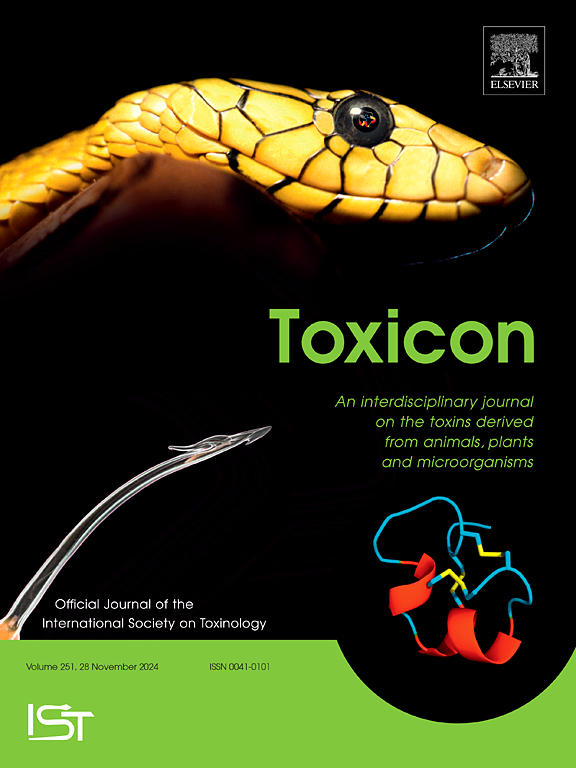缩短野刺鼠和大角田鼠毒液的致死性测定时间(LD50)和致死性中和测定(ED50):基于3rs的回顾性数据验证
IF 2.6
4区 医学
Q2 PHARMACOLOGY & PHARMACY
引用次数: 0
摘要
小鼠致死试验(MLA)仍然是评估抗蛇毒血清效力的金标准,尽管涉及动物福利的伦理问题。本研究评估了将MLA观察时间从48小时缩短至24小时,以测定野刺田鼠和大角田鼠毒液和抗蛇毒血清的中位致死剂量(LD50)和中位有效剂量(ED50)是否在提高动物福利的同时保持科学有效性。通过对2009-2023年在INCQS进行的518项质控分析(包括毒力测定334项和中位致死量测定27项)和ED50测定134项和LD50测定23项,我们发现超过98%的死亡发生在注射后24小时内,两种毒液的所有LD50测定和抗蛇毒血清的所有ED50测定均在注射后24小时内。统计分析表明,24小时和48小时的终点非常一致,所有试验的一致性相关系数都超过0.96。布兰德-奥特曼分析显示,在最小的系统偏差下,特别是在抗蛇毒血清效力测量方面,一致性的限制很窄。与标准48小时方案相比,分类性能指标在24小时内识别满意的抗蛇毒血清方面显示出极好的准确性(98.5%-100%),加权kappa系数超过0.98,表明近乎完美的一致性。对于C. d. terrificus, 24小时分类与48小时分类的准确率为100%,而B. jararaca抗蛇毒血清的准确率为98.5%,在334次分析中只有6次结果不一致。Kaplan-Meier生存分析证实了两个时间点之间的统计学上相等的生存概率。这些发现提供了强有力的证据,支持采用24小时观察期作为一种道德上优越的改进,既能保持科学的完整性,又能显著减少动物的痛苦。这种改进符合3Rs原则,可以提高抗蛇毒血清质量控制的测试效率,为其他生物分析的类似改进建立先例,并支持修订监管指南,以纳入更人性化的测试协议。本文章由计算机程序翻译,如有差异,请以英文原文为准。

Reducing time in lethality assay (LD50) for Bothrops jararaca and Crotalus durissus terrificus venoms and lethality neutralizing assay (ED50) for their respective antivenoms: A 3Rs-based retrospective data validation
Mouse lethality assays (MLA) remain the gold standard for evaluating antivenom potency despite ethical concerns regarding animal welfare. This study assessed whether reducing observation periods from 48 to 24 h in MLA for determining median lethal dose (LD50) and median effective dose (ED50) of Bothrops jararaca and Crotalus durissus terrificus venoms and antivenoms maintains scientific validity while improving animal welfare. Through retrospective analysis of 518 quality control assays conducted between 2009–2023 at INCQS, including 334 potency assays and 27 median lethal dose assays for B. jararaca, and 134 ED50 assays and 23 LD50 assays for C. d. terrificus, we found that over 98% of deaths occurred within the first 24 h post-injection for all LD50 determinations on venoms and all ED50 determinations on antivenoms for both species. Statistical analyses demonstrated exceptional agreement between 24-hour and 48-hour endpoints, with concordance correlation coefficients exceeding 0.96 for all assays. Bland–Altman analysis revealed narrow limits of agreement with minimal systematic bias, particularly for antivenom potency measurements. Classification performance metrics showed excellent accuracy (98.5%–100%) in identifying satisfactory antivenoms at 24 h compared to the standard 48-hour protocol, with weighted kappa coefficients exceeding 0.98, indicating near-perfect agreement. For C. d. terrificus antivenom, the 24-hour assay demonstrated 100% concordance with the 48-hour classification, while B. jararaca antivenom showed 98.5% accuracy with only 6 discordant results among 334 assays. Kaplan–Meier survival analysis confirmed statistically equivalent survival probabilities between both time points. These findings provide robust evidence supporting the adoption of a 24-hour observation period as an ethically superior refinement that maintains scientific integrity while significantly reducing animal distress. This refinement aligns with the 3Rs principles and could enhance testing efficiency in antivenom quality control, establishing a precedent for similar refinements in other biological assays and supporting the revision of regulatory guidelines to incorporate more humane testing protocols.
求助全文
通过发布文献求助,成功后即可免费获取论文全文。
去求助
来源期刊

Toxicon
医学-毒理学
CiteScore
4.80
自引率
10.70%
发文量
358
审稿时长
68 days
期刊介绍:
Toxicon has an open access mirror Toxicon: X, sharing the same aims and scope, editorial team, submission system and rigorous peer review. An introductory offer Toxicon: X - full waiver of the Open Access fee.
Toxicon''s "aims and scope" are to publish:
-articles containing the results of original research on problems related to toxins derived from animals, plants and microorganisms
-papers on novel findings related to the chemical, pharmacological, toxicological, and immunological properties of natural toxins
-molecular biological studies of toxins and other genes from poisonous and venomous organisms that advance understanding of the role or function of toxins
-clinical observations on poisoning and envenoming where a new therapeutic principle has been proposed or a decidedly superior clinical result has been obtained.
-material on the use of toxins as tools in studying biological processes and material on subjects related to venom and antivenom problems.
-articles on the translational application of toxins, for example as drugs and insecticides
-epidemiological studies on envenoming or poisoning, so long as they highlight a previously unrecognised medical problem or provide insight into the prevention or medical treatment of envenoming or poisoning. Retrospective surveys of hospital records, especially those lacking species identification, will not be considered for publication. Properly designed prospective community-based surveys are strongly encouraged.
-articles describing well-known activities of venoms, such as antibacterial, anticancer, and analgesic activities of arachnid venoms, without any attempt to define the mechanism of action or purify the active component, will not be considered for publication in Toxicon.
-review articles on problems related to toxinology.
To encourage the exchange of ideas, sections of the journal may be devoted to Short Communications, Letters to the Editor and activities of the affiliated societies.
 求助内容:
求助内容: 应助结果提醒方式:
应助结果提醒方式:


